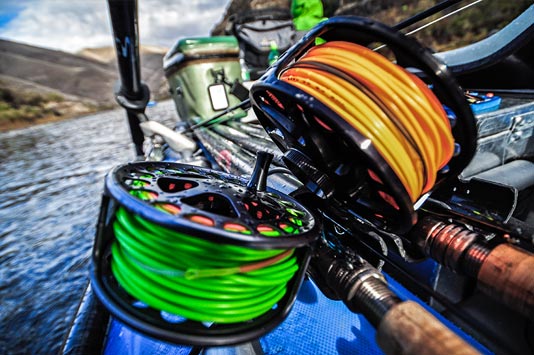Spey vs Switch Rods
Sean Visintainer - 09/25/14

Two hands are better than one!
We often get the question in the shop what is the difference between spey and switch rods? Why would you choose one over the other and why would you spey cast instead of single hand cast? To help people understand some of the differences between these two rod terms I made a short video to discuss this as well as give 4 reasons as to why you spey cast in certain situations.
What are some commonalities between spey and switch rods?
- Spey and switch rods utilize two-hands to cast the line.
- They are substantially longer than traditional single hand rods.
- They are larger for their given line weight when compared to the same line weight in single hand rods. For example... a 7wt single hand rod cast a line best with a line weighing approximately 185grains +/- versus a 7wt spey rod cast a line weighing approximate 480grains +/- .
- Both are designed be cast "spey style" meaning you use the line on the water to load the rod.
- Both can be used for swinging subsurface flies (traditional steelhead flies, leeches, trout streamers, soft hackles, etc)
- Both can be used for nymphing techniques.
- Spey and switch rods can cast dry flies, however, they lack the finesse and accuracy of single hand rods. Because of this, if you fish dries with these style rods you find larger dry flies like chernobyls, hoppers, stoneflies, etc to work best. They are more suited for "skating" dries.
What are some differences between spey and switch rods?
- Spey rods are 12'6" - 14' plus in length.
- Switch rods are 10'1" - 12'5" in length.
- Switch rods in theory can be cast with both hands or with just one hand. This depends on the type of line you are casting. I personally would not want to "single hand" a switch rod all day though.
- Switch rods overall will cast lighter grain weighs when compared to the same line weight in a spey rod. This is dictated by the difference in rod length.
- Because spey rods are longer, it is easier to cast further distances.
- Switch rods are better suited for nymphing than spey rods because of their shorter length and lighter weight makes them easier to stack mend line or highstick line.
- When swinging flies, spey rods can manage more line on the water because of their longer length.
4 Advantages of Spey Casting
- The ability to cast tight against the bank with trees, rocks, or brush behind you.
- Cast further distances easier, and still have the ability to manage your line.
- Dealing with wind. Spey casting can easily be done off of either shoulder to combat the wind. Spey line also punches through the wind better.
- Casting heavy rigs, sink-tips, split shot, strike indicators, etc is easier and more efficient with two-handed rods.
Check out my short video to learn more about how spey and switch rods can be a great tool in your fishing arsenal:
